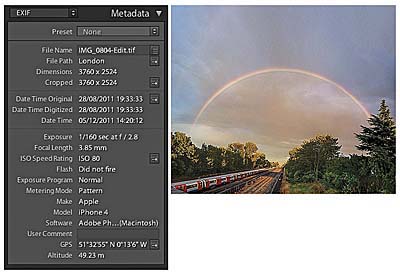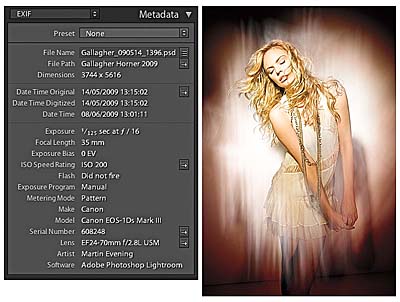Working with Metadata in Adobe Photoshop Lightroom 4
- The different types of metadata
- A quick image search using metadata
In the early days of digital photography many photographers would rely solely on a folder-based organizational system and remarkably I do come across busy, successful photographers who are still relying on folders to manage their entire image library. With a folder-based organizational system, the degree to which you can successfully retrieve specific images depends on your ability to memorize the folder structure of the hard drive and know where everything is stored. Anyone who is responsible for maintaining a large image archive will already be aware that this method of file management can soon become unwieldy. What is needed is a cataloging program that can help you keep track of everything. Therefore, the trend these days is to use file management by metadata, where you search for a file by searching its attributes rather than trying to remember which folders you put the pictures in.
At the heart of any digital asset management (DAM) system is the ability to manage the files stored on that system through the use of metadata. A good DAM system should allow you to filter files using the metadata that is already embedded, as well as add custom metadata tags that can be used to carry out refined file searches and organize files into custom groupings. Some examples have already been shown in this book, such as the use of the filmstrip filter to narrow down a selection of photos and view only those images with ratings of one star or higher, or two-star images only, and so on. We have also looked at how to use the Folders panel to manage the image library. But the real power behind Lightroom is the database engine, which allows you to carry out specific searches and quickly help you find the photos you are looking for (see Figure 10.1 and Figure 10.2).

Figure 10.1 Metadata information can be valuable to any type of photo library. Here for example, is a photograph that I shot recently. As you can see from the EXIF metadata, this was taken using an iPhone. So in addition to showing the time and date this photo was made, it also recorded the GPS coordinates. I used the Keywording panel to add the following keywords: rainbow > Weather, sky > Weather, summer > Seasons, train > public transportation > land transportation > Transportation, Willesden Green > London > UK. This extra information may prove valuable to me personally in the future as I look back through personal snapshots.

Figure 10.2 Metadata information becomes even more important when managing a photo library of commercially shot photographs. Here, things like the camera settings and lens EXIF metadata can be useful for filtering photos by those shot with, say, a particular lens. Meanwhile, the IPTC and keywording metadata that’s added manually can be used to record all the key information associated with each individual shot. Here I used the Keywording panel to add the following keywords: Brian Gallagher > Hair stylists, Camilla Pascucci > Makeup artists, Gallagher Horner > Jobs, Harriet Cotterill > Clothes stylists, M&P > Model agencies, Veronica > Models.
It is in no way mandatory that you follow all of the advice offered in this chapter, as each person will have his or her own particular image management requirements. You may indeed find that you just want to use the Folders panel to catalog your library images and that is enough to satisfy your needs. But hopefully one of the key things you will learn in this chapter is that the time invested in cataloging an image collection can pay huge dividends in terms of the time saved when tracking down those pictures later. The image management tools in Lightroom are far from being a complete asset management solution, but they do offer something for nearly everyone. Some people may find the cataloging tools in Lightroom insufficient. But even so, the data you input via Lightroom will be fully accessible in other image asset management programs. But once you start adding metadata to your images and grasp the benefits of doing so, the process can become addictive.
The different types of metadata
Metadata is usually described as being data about data, which is used to help categorize information. Most of us carry out metadata searches on a daily basis. Every time you use an Internet search engine such as Google™ you are using metadata to find what you are looking for. For example, if you type in a search for “elephants” and then click on the “Images” filter, you can quickly locate lots of photographs of elephants (over 11 million photographs). But if you were to refine the search criteria to “Indian elephants ceremonial,” you could start to narrow the search down further. If you want to find an e-mail that was sent to you over a year ago you can probably use the search tools in your mail program to quickly find what you are looking for. An MP3 player such as an iPod is able to make use of embedded metadata to help you locate specific music and a cable TV system will typically allow you to search for movies in a variety of ways. You can probably search for a specific film title by genre, release date, or director.
Lightroom also lets you organize your image files by metadata. Most digital image files will contain a certain amount of camera information data (known as EXIF metadata) to describe things like the camera and lens used, along with other technical information such as the lens settings and image file type. The thing is, the information that would be considered important, such as who or what was in the picture when the photograph was shot, won’t be included automatically. Here it is down to the photographer to add such custom metadata information manually by entering keywords that help describe the image. Keywords can be used to categorize the photos in your catalog and if you are skilled at keywording this can really help you manage your photos extremely efficiently, as well as improve sales if you are in the business of supplying photos to an agency.
It is true that you will need to spend time entering all this metadata information (although there are various tips coming up in this chapter that show you how to avoid repetitively entering this data for every single image). But the trade-off is that the time invested in cataloging your images in the early stages can help reap rewards later in the time saved retrieving your files. In most cases you only need to configure essential metadata once to create a custom metadata template. You can then apply this bulk metadata automatically to a set of imported photos. You can take the metadata cataloging further and add extensive custom metadata information to individual images. It really all depends if this is important for the type of work you do. Basically, the effort spent adding metadata should always be proportional to how useful that information may be later. There is no point in going overboard with the amount of time spent entering metadata. How much time you should devote to this task and the amount of detailed information you record will all be down to how important that information will be to you personally and/or the people you are supplying your images to.
There is a lot of detailed content coming up in this chapter about how to apply, edit, and use metadata. I thought, therefore, that the best way to introduce this subject would be to provide first a quick example of how metadata can be used to carry out a search in the Lightroom catalog.